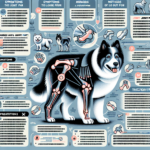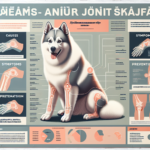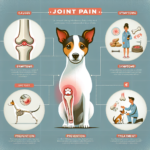Icelandic Sheepdog Joint Pain: Causes, Symptoms, Prevention, and Treatment

Introduction
The Icelandic Sheepdog is a breed with a rich history and unique characteristics that make it a beloved companion for many dog enthusiasts. Originating from Iceland, this breed was initially used for herding livestock and guarding farms. Known for their friendly and energetic nature, Icelandic Sheepdogs are medium-sized dogs with a thick double coat, erect ears, and a bushy tail that curls over their back. They are highly intelligent, agile, and have a strong herding instinct, making them excellent working dogs as well as family pets.
Like many breeds, Icelandic Sheepdogs are prone to certain health issues, with joint pain being a significant concern. Joint health is crucial for maintaining the breed’s active lifestyle and overall well-being. Understanding the causes, symptoms, prevention, and treatment of joint pain in Icelandic Sheepdogs can help owners ensure their pets lead a healthy and comfortable life.
Breed-Specific Joint Pain Risks
Genetic Predisposition
Icelandic Sheepdogs, like many purebred dogs, have a genetic predisposition to certain joint-related issues. Hip dysplasia, a condition where the hip joint does not fit properly into the hip socket, is relatively common in this breed. This can lead to arthritis and significant pain over time. Elbow dysplasia, another genetic condition, affects the elbow joint and can cause similar issues. Both conditions are hereditary and can be exacerbated by environmental factors.
Age-Related Risks
As Icelandic Sheepdogs age, they become more susceptible to joint pain and related conditions. While younger dogs may show few signs of joint issues, older dogs often develop arthritis, a degenerative joint disease that causes inflammation and pain. Owners should be particularly vigilant as their dogs approach middle age, typically around 6-8 years old, as this is when joint problems often begin to manifest.
Activity Level and Joint Stress
Icelandic Sheepdogs are known for their high energy levels and need for regular exercise. While their active lifestyle is beneficial for overall health, it can also contribute to joint stress, especially if the dog engages in high-impact activities like jumping or running on hard surfaces. Working dogs or those involved in sports may be at higher risk for joint injuries and long-term wear and tear.
Common Symptoms of Joint Pain in Icelandic Sheepdogs
General Symptoms
- Limping: One of the most noticeable signs of joint pain is limping or favoring one leg over another.
- Stiffness: Dogs may show stiffness, especially after resting or sleeping, which can indicate joint discomfort.
- Reluctance to Move: A dog that is hesitant to climb stairs, jump, or engage in physical activities may be experiencing joint pain.
- Swelling: Visible swelling around the joints can be a sign of inflammation and pain.
- Behavioral Changes: Irritability, lethargy, or changes in appetite can also be indicators of joint pain.
Breed-Specific Symptoms
In Icelandic Sheepdogs, joint pain may manifest in specific ways due to their unique build and activity levels. Owners might notice a decrease in their dog’s herding behavior or agility performance. Additionally, the breed’s thick coat can sometimes mask swelling, so careful observation is necessary.
When to Consult a Vet
If an Icelandic Sheepdog shows any signs of joint pain, it is essential to consult a veterinarian promptly. Early intervention can prevent further deterioration and improve the dog’s quality of life. Persistent limping, noticeable pain, or significant changes in behavior should all prompt a veterinary visit.
Preventive Measures for Joint Health
Exercise Recommendations
Regular, low-impact exercise is crucial for maintaining joint health in Icelandic Sheepdogs. Activities like swimming, walking on soft surfaces, and controlled play can help keep joints flexible without causing excessive stress. Avoiding high-impact activities like jumping or running on hard surfaces can also reduce the risk of joint injuries.
Dietary Suggestions
A balanced diet rich in essential nutrients can support joint health. Foods containing glucosamine, chondroitin, and omega-3 fatty acids are particularly beneficial. These nutrients help maintain cartilage health and reduce inflammation. Owners may also consider supplements specifically designed for joint health, but it is essential to consult a veterinarian before adding any new supplements to the dog’s diet.
Weight Management
Maintaining a healthy weight is critical for reducing joint stress. Excess weight can exacerbate joint problems and lead to more severe pain and mobility issues. Owners should monitor their dog’s weight and adjust their diet and exercise routine as needed to keep them at an optimal weight.
Early Screening and Monitoring
Regular veterinary check-ups and early screening for joint issues can help catch problems before they become severe. For Icelandic Sheepdogs, screening for hip and elbow dysplasia is particularly important. Early detection allows for more effective management and treatment options.
Treatment Options for Joint Pain
Non-Surgical Treatments
Non-surgical treatments for joint pain in Icelandic Sheepdogs include medications, physical therapy, and lifestyle adjustments. Anti-inflammatory drugs and pain relievers can help manage pain and reduce inflammation. Physical therapy, including exercises and massage, can improve joint mobility and strength. Lifestyle adjustments, such as providing a comfortable bed and avoiding high-impact activities, can also alleviate joint pain.
Surgical Options
In severe cases, surgical intervention may be necessary. Common surgeries for joint pain include hip replacement, arthroscopy, and joint fusion. These procedures can significantly improve the dog’s quality of life, but they come with risks and require a thorough discussion with a veterinarian.
Alternative Therapies
Alternative treatments like acupuncture, hydrotherapy, and massage can also benefit Icelandic Sheepdogs with joint pain. Acupuncture can help reduce pain and inflammation, while hydrotherapy provides low-impact exercise that strengthens muscles without stressing the joints. Regular massage can improve circulation and reduce muscle tension around the affected joints.
Lifestyle and Management Tips
Daily Care Routine
A daily care routine for an Icelandic Sheepdog with joint pain might include gentle exercise, a balanced diet with joint supplements, and regular physical therapy sessions. Providing a comfortable resting area and monitoring the dog’s weight are also essential components of daily care.
Modifying the Home Environment
Making the home environment more comfortable for a dog with joint pain can significantly improve their quality of life. Consider using ramps instead of stairs, providing orthopedic beds, and ensuring that food and water bowls are at an accessible height. Non-slip mats can also help prevent falls and reduce joint stress.
Long-Term Management
Long-term management of joint pain involves regular veterinary check-ups, ongoing physical therapy, and consistent monitoring of the dog’s condition. Adjusting the dog’s exercise routine and diet as needed can help manage pain and maintain mobility. Owners should also be prepared to make lifestyle changes to accommodate their dog’s needs as they age.
FAQs About Icelandic Sheepdogs and Joint Pain
What are the early signs of joint pain in Icelandic Sheepdogs?
Early signs of joint pain include limping, stiffness, reluctance to move, and behavioral changes such as irritability or lethargy.
Can joint pain in Icelandic Sheepdogs be prevented?
While genetic predispositions cannot be entirely prevented, maintaining a healthy weight, providing regular low-impact exercise, and ensuring a balanced diet with joint-supporting nutrients can help reduce the risk of joint pain.
Are there specific exercises that are better for Icelandic Sheepdogs with joint pain?
Yes, low-impact exercises like swimming and walking on soft surfaces are ideal for Icelandic Sheepdogs with joint pain. These activities help maintain joint flexibility without causing excessive stress.
What dietary supplements are recommended for joint health in Icelandic Sheepdogs?
Supplements containing glucosamine, chondroitin, and omega-3 fatty acids are beneficial for joint health. Always consult a veterinarian before adding new supplements to your dog’s diet.
When should I consider surgery for my Icelandic Sheepdog’s joint pain?
Surgery should be considered when non-surgical treatments are no longer effective, and the dog’s quality of life is significantly impacted. A thorough discussion with a veterinarian is essential to determine the best course of action.
Conclusion
Joint pain is a common concern for Icelandic Sheepdogs, but with proper care and attention, it can be managed effectively. Understanding the causes, symptoms, prevention, and treatment options is crucial for maintaining your dog’s joint health. Regular veterinary check-ups, a balanced diet, appropriate exercise, and early intervention can help ensure your Icelandic Sheepdog leads a happy and active life. By taking preventive measures and consulting with your veterinarian regularly, you can provide the best possible care for your beloved pet.




